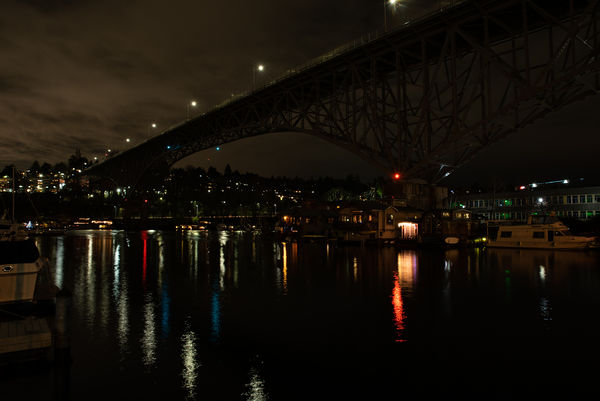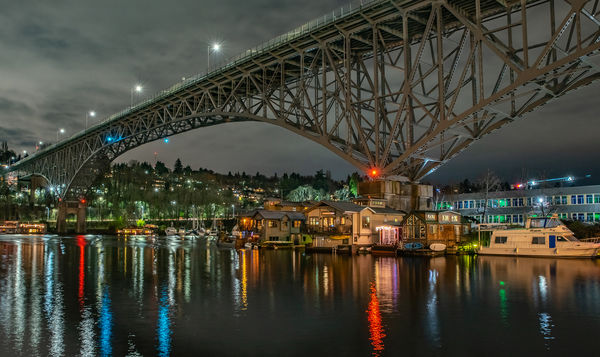What is the difference if you are shooting RAW?
Jan 7, 2020 07:47:42 #
If you shoot RAW, then the camera dumps nearly all the data generated by the light falling onto your camera sensor into a file. That being the case, does it make any sense to fiddle with your ISO if you are shooting in a low light situation at the slowest shutter speed and lowest f/stop you feel comfortable with? The question is, in this situation, does your camera do anything different with the light data at a given shutter speed/aperture just because you change that setting? It seems to be that the answer is no, it makes no difference, but maybe someone out there knows more than I.
Jan 7, 2020 07:57:01 #
I’m no techno wizard and therefore can’t give a definition from a physics standpoint, but changing the ISO certainly makes a difference in my images.
Jan 7, 2020 08:04:19 #
mizzee
Loc: Boston,Ma
It does make a difference. Try an experiment by shooting at ISO 200 at night and see how good the image is once you get into post and up the exposure. I think you’ll find that the result won’t be a wall hanger.
Jan 7, 2020 08:10:37 #
I never shoot RAW but my WAG is that shooting as close to possible to what the scene requires to begin with makes for a better finished photo.
Dennis
Dennis
Jan 7, 2020 08:14:22 #
It depends on your camera model. Research the topic ISO Invariance where the idea is that at 'base ISO', typically ISO-100 for most of the models with this feature, the RAW file can be modified in post processing without a negative impact on the image noise.
The capability of ISO Invariance is very a) model (brand) and b) software and c) situation specific. If you under-exposed by 5-stops to keep and image at ISO-100, compare for yourself whether you can edit an equivalent (or better) version of the image when brightened on your computer to the equivalent of ISO-3200 or higher. Experiments with your own unique camera and software combination may show that you should be fiddling with the ISO in the camera for low light situations to achieve the better final result.
Your low-light situation may also require a faster shutterspeed that can't be accomplished by just a wide aperture at the camera's base ISO. ISO Invariance may be a feature of your camera model, but still is not a solution for all your needs.
The capability of ISO Invariance is very a) model (brand) and b) software and c) situation specific. If you under-exposed by 5-stops to keep and image at ISO-100, compare for yourself whether you can edit an equivalent (or better) version of the image when brightened on your computer to the equivalent of ISO-3200 or higher. Experiments with your own unique camera and software combination may show that you should be fiddling with the ISO in the camera for low light situations to achieve the better final result.
Your low-light situation may also require a faster shutterspeed that can't be accomplished by just a wide aperture at the camera's base ISO. ISO Invariance may be a feature of your camera model, but still is not a solution for all your needs.
Jan 7, 2020 08:27:40 #
LCD wrote:
If you shoot RAW, then the camera dumps nearly all... (show quote)
Am I the only one that has actually tried changing ISOs on my digital cameras? I shoot RAW most of the time. And certainly have shot JPGs enough (mainly in the past) to see the effects of various setting changes on my cameras. With RAW many choices or effects only really effect the starting thumbnail that comes up in ACR or other RAW editor. With JPGs you may be stuck with those choices. But ISO like the other parts of the exposure triangle are not actually changeable after an exposure is taken. How would you change F-Stop or Shutter Speed. Yes, you can change the Exposure or Brightness of your image in Ps, Lr, or other, but that is like turning up or down the volume or gain to a music sound amplifier. Or say in film photography pushing or pulling the development of the film.
Jan 7, 2020 09:06:21 #
LCD wrote:
If you shoot RAW, then the camera dumps nearly all the data generated by the light falling onto your camera sensor into a file...
The raw data contains all the data from the sensor but it's first run through the readout electronics. Changing the ISO setting changes the amplification in the readout electronics so the ISO will affect the data recorded in the raw file.
There are four settings of your camera that affect the raw data: ISO, focus, shutter speed, and aperture. These things can't be modified in postprocessing (although some software does attempt to correct for focus/camera motion problems, with limited success).
Jan 7, 2020 09:21:23 #
LCD wrote:
If you shoot RAW, then the camera dumps nearly all... (show quote)
In terms of the ISO decision you propose, sometimes there is a difference, other times less so. Others with more expertise than I can add more, but it depends on your camera to a large extent. Read about ISO Invariance in articles like this https://improvephotography.com/34818/iso-invariance/. For some cameras, and at some settings, what you propose is true, and capturing an overdark image at base ISO and brightening it in post will give you much the same quality image as if you captured it at the "proper" ISO for the scene.
My camera is ISO Invariant to a certain point, but it reaches that point sooner than more expensive and larger sensor cameras do. Up until that point, I sometimes get a better image by underexposing on the ISO side and brightening it in post. Past that point I get a better image file by raising the ISO or even slightly overexposing. I've kinda figured out which kinds of compensation (I think of ISO as a compensation) will deliver the better file to work with based on the variables of the scene and settings. It behooves us to know our cameras in order to maximize the outcomes of these kinds of decisions.
Jan 7, 2020 09:25:56 #
minniev wrote:
That is it in a nutshell! This observation applies to many of the questions asked in main forum.... It behooves us to know our cameras in order to maximize the outcomes of these kinds of decisions.
So much depends on one's camera and with every year's changes in design and other features, what used to be true is probably not today.
Jan 7, 2020 09:40:24 #
Jan 7, 2020 09:58:16 #
LCD wrote:
If you shoot RAW, then the camera dumps nearly all... (show quote)
Try this. Set the ISO at 100. Set the aperture and shutter speed to give you a normal exposure with an average scene. Change the ISO to 800 keeping the same aperture and shutter speed. You will find even if you shoot RAW you will lose the highlight at the higher ISO setting.
Doing it the other way around that is set the ISO to 800 and then set the aperture and shutter speed for a normal exposure. Then reduce the ISO to 100 and keep the same aperture and shutter speed. You will find that you can recover the shadow in the one with ISO 100 and the you can get pretty much the same results if you shoot RAW. Now you say nothing is lost? Yes but you don't see it because the one with ISO 100 you lose the number of bits represent from darkest to brightest in your scene.
Jan 7, 2020 11:33:01 #
LCD wrote:
If you shoot RAW, then the camera dumps nearly all... (show quote)
It does not matter in what format you're shooting, you as the photographer make all the decisions on your settings to get to your desired outcome! If you're wanting the camera do everything, shoot in all automatic, or have someone else take pictures for you. Raw only gives you more leeway in pp and that's all there is to it!
Jan 7, 2020 12:00:17 #
a6k
Loc: Detroit & Sanibel
I can only be certain of this for my two Sony cameras: a6500 and RX10 IV.
RawDigger proves that ISO affects the raw file. That is very probably because the analog-digital conversion includes amplification.
SONY does its raw file differently than other brands. RawDigger would be the best way to test this for any brand.
RawDigger proves that ISO affects the raw file. That is very probably because the analog-digital conversion includes amplification.
SONY does its raw file differently than other brands. RawDigger would be the best way to test this for any brand.
Jan 7, 2020 12:35:21 #
DirtFarmer wrote:
The raw data contains all the data from the sensor
but it's first run through the readout electronics.
Changing the ISO setting changes the amplification
in the readout electronics so the ISO will affect the
data recorded in the raw file.
The raw data contains all the data from the sensor
but it's first run through the readout electronics.
Changing the ISO setting changes the amplification
in the readout electronics so the ISO will affect the
data recorded in the raw file.
So in short, photographic "RAW" files will not
usually fit the dictionary definition of "RAW".
IOW they aren't really absolutely "not cooked".
Staying with kitchen terms, so-called RAW files
are not straight from the garden or the butcher.
They are not fully cooked and ready to eat, but
they have been somewhat "prepped".
Prepping can make or break the finished dish,
the texture, the taste, of both food and photos.
Jan 7, 2020 13:56:45 #
Taken with a Nikon D810 (a reportedly ISO invariant camera) and a Tamron 24x70, f/2.8 lens at 24MM, 6 seconds, f/8 and ISO 320. The first shot is SOC. The second processed in ACR and Photoshop. I believe I could have used an even lower ISO and achieved the same result.
If you want to reply, then register here. Registration is free and your account is created instantly, so you can post right away.










